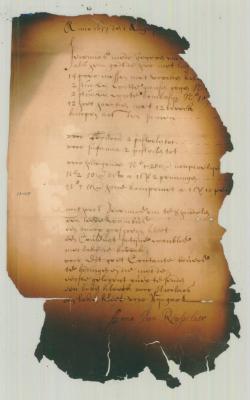Interpreting the Evidence
Invoice Listing Goods Shipped from Amsterdam to New Netherland, July 21, 1654 and August 1, 1654
Suggested Teaching Instructions
Document Description
Listing of goods and their values to be shipped from Amsterdam and sold in New Netherland by Cornelius van Schel and Jeremias van Rensselaer. Signed by Anna van Rensselaer. Dated July 21, 1654 and August 1, 1654.
Historical Context
The West India Company brought the first settlers to New Netherland to gather beaver pelts to sell back in the Netherlands but they had a hard time finding enough people to settle the colony. In an effort to attract more people, the company decided to give private entrepreneurs pieces of land in New Netherland if the entrepreneurs (patroons) promised to ship fifty colonists to it within four years. So, in 1631, a Dutch diamond merchant named Killiaen van Rensselaer bought a large tract of land around Fort Orange from the Mahicans who had long lived there. He established a "patroonship," or private farming community, which he named Rensselaerswijck. Many patroons bought land, but Kiliaen Van Rensselaer was the only one who was able to build a successful colony. His patroonship, Rensselaerswyck, lasted into the nineteenth century, passing down through generations of the Van Rensselaer family.
Kiliaen Van Rensselaer never visited America, but he worked hard to make his patroonship a success. Rensselaerswyck grew quickly, with a steady stream of farmers and tradesmen coming from Europe. Farming was the main activity in the patroonship. The products of farming were used to support the growing patroonship, but also the settlers in colonies nearby. Van Rensselaer had thought that the nearby West India Company settlement of Fort Orange, in the area of present day Albany, and his own colony of Rensselaerswyck would be mutually supporting: the fort would provide protection, and the patroonship would supply the fort with goods. Van Rensselaer hoped to make a profit by selling goods to the settlers in the fort. But the two settlements were so close to each other that they competed for profits, leading to a tense relationship between the patroon and the West India Company that controlled the fort.
Kiliaen Van Rensselaer never visited America, but he worked hard to make his patroonship a success. Rensselaerswyck grew quickly, with a steady stream of farmers and tradesmen coming from Europe. Farming was the main activity in the patroonship. The products of farming were used to support the growing patroonship, but also the settlers in colonies nearby. Van Rensselaer had thought that the nearby West India Company settlement of Fort Orange, in the area of present day Albany, and his own colony of Rensselaerswyck would be mutually supporting: the fort would provide protection, and the patroonship would supply the fort with goods. Van Rensselaer hoped to make a profit by selling goods to the settlers in the fort. But the two settlements were so close to each other that they competed for profits, leading to a tense relationship between the patroon and the West India Company that controlled the fort.
Essential Question
How did the residents of Rensselaerswyck attempt to satisfy their basic economic needs?
Check for Understanding
Explain why these items would be needed in the colony.




